Armando Poli and Marco Ceccarelli at 7 o'clock of a morning bright and clear and we are in Pila, never stop, we arrive at Lago Gelato, where sgranocchiamo an apple and sip tea ; surpass the very blue lake as bright as that of the frame fresh snow brings out even more. Let's go upward to the Capuchins then I like to climb all the rocks that I find on the ridge. Sometimes here and sometimes there. At 11:00 am are at the top, while the other two, a little weary, come later. I put the bag in a safe place, because a strong wind blowing and icy. To inspect the North, all snowy, go down along the West Ridge to the
, then I go back and, after seeing them, but still too low, until I decide to get off the East Ridge to observe the great wall, that of Laures. When I return, they too are in Summit.
Almost. At 11.35 hours, slowly under a brutal sun, we go listening to the little radio that breaks the silence, beautiful but at times exhausting.
the South Slope of Emilius desperately in search of water, we hear bubbling under the large blocks that jump. Eventually I guess the right vein and from there a short time also the source, located in a small cave in under two boulders. I put the same effort in collecting patience with water dripping from stalactites ice. We drink our fill and then, while others take the sun, like a madman I start to climb
with thousands of combinations on the base of the base of the South Face What you want, is the age! We're leaving this gym but I improvised sparked a new desire to go up: given, after crossing a moraine on the slope above Lake Frozen, backpack Armando decided to go upwards again, this time to the Little Emilius
. This Top is going uphill for the first time by the Abbé Henry just from this side I am going to go up (wrong because the abbot had reached him through the crest and Henry is not written with the accent, but then I knew and did not know why C.A.I. to a reading of its report had done, but then I remembered what I remember). The time is 13:20 and I hope to be back by 15.00 hours at the lake, where they are directed; climb so fast moraines below the South-southwest wall that soon I see my friends away. I stop and slow down when I realize I'm really going to be running. Check the first red rocks, solid and beautiful but quite inclined and then bon difficult to climb (II° and something more), and in fact in short are at the top. I look at my watch and realize that they are just the hours of 13.40 and then I did this climb in only 20 minutes (!).
, admiring the impressive North Slope and below that rushes over the Arpisson. Finally I decided to go down further east on a land much easier ( Via descent Bozzino 1910) and soon I realize that I'm running again and this time in a crazy , at 14.15 are from my friends at the edge of "sweet" lake from which, unfortunately, we must soon go away and at 17.30 we reach Pila, where , after numerous attempts, we can have a place in the car by a deer hunter Jovençan.
So, after the Pic Garin, I went in the footsteps of Abbé Grégoire and also on Emilius and ... on Little.
Con l'Armando Poli ed il Marco Ceccarelli alle ore 7 di un mattino chiaro e luminoso siamo a Pila e, senza mai fermarci, arriviamo al Lago Gelato, dove sgranocchiamo una mela e sorseggiamo il té; sorpassiamo il lago tanto luminoso quanto molto azzurro che la cornice di neve fresca esalta ancor più. Andiamo sù ai Cappuccini, poi mi diverto a scalar tutti i massi che trovo sulla cresta. A volte di qua ed a volte di là. Alle ore 11,00 son in vetta, mentre gli altri due, un pò affaticati, arrivan più tardi. Poso lo zaino in un posto sicuro, poiché soffia un vento molto forte e gelido. Per ispezionare la Nord, tutta innevata, scendo lungo la Cresta Ovest fino al
, poi risalgo e, dopo averli visti, ma ancora troppo in basso, in attesa decido di scender la Cresta Est per osservare la grande parete, quella delle Laures. Quando ritorno, anche lor son'in Cima.
Quasi. Alle ore 11,35, lentamente sotto un sole bestiale, ce ne andiamo ascoltando la piccola radio che rompe il silenzio, bello ma a volte anche estenuante. "Tagliamo" il Versante Sud dell'Emilius disperatamente in cerca d'acqua, che sentiamo gorgogliare sotto ai grandi blocchi che saltiamo. Alla fine indovino la vena giusta e da lì a poco tempo anche la sorgente, situata in una piccola grotta al di sotto di due macigni. Mi infilo a fatica nella medesima raccogliendo con pazienza l'acqua che gocciola dalle stalattiti glaciali. Beviamo a sazietà poi, mentre gli altri prendono il sole, com'un forsennato mi metto ad arrampicare
con mille combinazioni sullo zoccolo di base della Parete Sud. Che volete, é l'età! Ce ne andiam ma questa ginnastica improvvisata m'ha suscitato nuova voglia di salire: affidato, dopo una traversata sul pendio morenico sopra il Lago Gelato, lo zaino all'Armando decido d'andar di nuovo sù; questa volta al Piccolo Emilius
. Questa Cima é stata salita per la prima volta dall'Abbé Hénry proprio da questo versante che m'accingo a salire (errato perché l'Abate lo aveva raggiunto tramite cresta ed Henry non si scrive con l'accento, ma allor sapevo e non sapevo perché al C.A.I. una lettura della sua relazione l'avevo fatta, ma poi ricordavo quel che ricordavo). Sono le ore 13,20 e spero d'esser di ritorno per le ore 15,00 al lago, dove loro si indirizzano; salgo talmente veloce le morene sottostanti la Parete Sud-sudovest che ben presto vedo lontani i miei amici. Mi fermo e rallento allorché m'accorgo di star veramente andando di corsa. Arrivo alle prime rocce rossastre, solide e belle ma abbastanza inclinate e quindi non difficili da salire (II° e qualcosa di più) ed in effetti in breve son in cima. Guardo l'orologio e m'accorgo che son appena le ore 13,40 e che quindi ho fatto questa salita in soli 20 minuti (!).
ammirando l'imponente e sottostante Versante Settentrionale che precipita sopra l'Arpisson. Infine mi decido a scendere più ad Est su di un terreno molto più facile (Via di discesa Bozzino 1910) ed in breve mi accorgo che stò nuovamente correndo e questa volta in maniera pazzesca; alle ore 14,15 sono dai miei amici ai bordi del "dolce" lago dal quale, purtroppo, dobbiam presto andar via ed alle ore 17,30 raggiungiamo Pila, dove, dopo innumerevoli tentativi, riusciam ad avere un posto in auto da parte d'un cacciatore di camosci di Jovençan.
Così, dopo il Pic Garin, son andato sull'orme dell'Abbé e di Grégoire anche sullo Emilius e ... sul Piccolo.
Six years have elapsed since I do not overlook the most if not the Cima, from this large balcony. The first Youth is past and, perhaps, even the second. One idea I have in mind for some time: the long climb up the spur from the Mount de Ròss Comboé down with various elevations and two hills until Arbolle. We start from Pila August 4th, 1974, and through the usual Chamolé, we go down to Arbolle Walloon, from above the
of the Shepherd Céteun (who died a year) climb easily to the Southwest Summit of a triple point (the Trident of Comboé ), which cross along scrupulously ridge. Beyond Top Northeast
things get complicated: a narrow slit, like a chimney, down, vertical for more than twenty metres, to below a hill which we call Comboé
, from which a dark red debris flow down towards the walloon of the same name. Pure magnetite or loadstone? The descend in free climbing (can be avoided by means of a ledge to the West) and reach the Hill of Comboé call. A fun and easy ridge leads us to Quota
, the first of a series of 7/8 elevations, which will become the Punta del Lago Gelato, which is easily seen from here in the East. The crossing of these is fun, even if the rock is not very good, but my
, in those days, to walk the edge of the ridge without the slightest unevenness avoid tired the Camille, who, having reached the Col Ròss,
. Ah, if only on Saturday evening went to sleep a little earlier instead of wandering around until late at night for the dance halls! And it also has the audacity to declare ... But using all my
, but above all the patience that you may have convinced him to 25 years, to continue. Telling a lot of lies and always being on the edge of the ridge. Reach so the Mount Ròss
, reaching the route of 1902, on which we build a small mound of stone. Here the ridge turns to the East, and easily leads to the Little Emilius
. By now you 've deceived by this point you will never go back. the next part it is not easy because small red towers, square stand in the way. Overcome these, not without some difficulty, because we start to get tired. Thus we reach a vertical grayish wall of
. same as the Abbot with Grégoire had circumvented in South to me is instead the sock idea to circumvent the opposite side, ie on the North Wall, as did the Daniele-Devalle with Mountain Guides Valtournanche in 1897 coming from the Walloon of Arpisson and overcoming the North Wall of the Little Emilius. A stupid, that instead of simplifying it complicates life. A traverse to the East marches on rocks with soil leads us, through the mist, to a bad rocky couloir, with soil poop, and from this we go back to a small red tooth back in crest. A great deal of fear for nothing to fear. Fatigue and tiredness are seeing things that do not exist. Briefly we Summit, after more than ten hours of departure.
Son trascorsi ben sei anni da quando non m'affaccio più, se non dalla Cima, da questo grande balcone. La prima Giovinezza é passata e, forse, anche la seconda. Un'idea che ho in mente da diverso tempo: salire il lungo contrafforte che dal Mont Ròss de Comboé scende con varie elevazioni e due colli fino ad Arbolle. Partiamo da Pila il 04 Agosto 1974 e, tramite il solito Colle di Chamolé, scendiamo nel vallone; da sopra il
"rifugio-ricovero" del Pastore Céteun (morto da un anno) saliamo facilmente alla Punta Sudovest di una triplice sommità (il Trident de Comboé), che attraversiamo percorrendo scrupolosamente sul fil di cresta. Oltre la Punta Nordest
(3083 m) le cose si complicano: una stretta fessura, a guisa di camino, scende verticale per oltre una ventina di metri ad un sottostante colle
(3014 m), che chiamiam di Comboé, dal quale una colata di detriti rosso cupi scende verso l'omonimo vallone. Pura magnetite? La scendiamo in arrampicata libera (può esser evitata tramite una cengetta ad Ovest) e raggiungiamo il colle. Una facile e divertente cresta ci conduce alla Quota
3150 metri, prima di una serie di 7/8 elevazioni, che diventerà la Punta del Lago Gelato, da qui ben in vista ad Oriente. La traversata di queste é divertente, anche se la roccia non é molto buona, ma la mia
"mania da purista", di quei tempi, di percorrer il fil di cresta senza evitar la benché minima asperità stanca il Camillo, che, giunti al Col Ròss,
é più che stufo di questo su e giù e, vista la possibilità d'una facile discesa verso il sottostante Plan Valé, ciò vuol far con 'na belle fuga tattica. Ah, se il Sabato sera andasse a dormir un pò prima invece di gironzolar fino a notte tarda per le sale da ballo! Ed ha anche la spudoratezza di dichiararlo ... Ma utilizzando tutta la mia
Arte Maieutica", ma soprattutto la grande pazienza che si può aver a 25 anni, lo convinco a proseguir. Raccontandogli un sacco di balle e restando sempre sul fil di cresta. Arriviamo così al Mont Ròss
(3201 m), raggiungendo la via del 1902, sul quale costruiamo un ometto in pietra. Qui la cresta volge ad Oriente e, facilmente, conduce al Piccolo Emilius
(3342 m). Ormai l'ho ingannato: da questo punto non si torna più indietro. La parte successiva non é facile perché piccole torri rosse e squadrate sbarran la strada. Le superiamo, non senza qualche fatica, perché cominciam ad essere stanchi. Così raggiungiamo un muro verticale grigiastro di
15/20 metri. Lo stesso che l'Abbé e Grégoire avevano aggirato a Sud. A me vien invece la balzana idea di passarlo sul versante opposto, cioé sulla Parete Nord, com'aveva fatto la cordata del 1897 arrivando dal Vallone dell'Arpisson e superando la Parete Nord del Piccolo Emilius. Una stupidaggine, che invece di semplificar ci complica vita. Una traversata ad Est su rocce marce, con terriccio di cacca, ci porta, in mezzo alla nebbia, ad un canale, non meglio del traverso, e da questo risaliam verso un dentino rosso ritornando in cresta. Quanta paura per nulla. La fatica e la stanchezza fan veder cose inesistenti. In breve siamo in Cima, dopo più di dieci ore dalla partenza.
Proprio gente che non ha nulla da far nella vita ...
"To avoid a small passage, look at what we got shit ... we went into this shit! / Per evitar un passaggetto del cavolo, varda in che merdaio siam andati finir!"
Sunday, August 01th, 1976:
Two years later we are going to repeat the route Abbé & Gregory on this ridge, starting at Hill Carrel rises to Mount Ròss and from there to Emilius; scarcely used for climbing and this can not explain the reason. We want to go and look around, if only to see this famous
"Cappuccino", which tells the Abbot, who looks at you from tall, grim and threatening. As usual, let us go up to the first stack from
"Becca" to take a look at the entire route, then go down the hill and below the small lake at the ruins of the House-Shelter of the Gamekeepers by Baron Beck Peckoz; a thick fog does not allow us to see anything, and so we must wait and we are hesitant to leave. Then we get tired and we decided to go anyway. The climb is not difficult, and soon reach the big Tooth
(3150m) (wrongly
3050m I.G.M.) that stands in the way. The first response we have it and we begin to understand why in 1902 they had to turn right and go up with scenes from the edge of the West Wall of the Mount Ròss. A vertical jump of
about 25 metres preclude the possibility of continuing. We continue down equally free climbing on the ridge (III° +, very exposed; rock is not good); dropped Camillo, I also go down very close to the underlying small fork (this is the part where you have placed the Tibetan catwalk in the current Via Ferrata). Then continue blithely on broken rock and large boulders stacked, but there are difficulties and, if anything, peeked through the fog if we can glimpse this famous rock in the form of
"Capuchin" which tells the Abbot. Look here, look there is nothing to see. One could be that but we're not sure.
Instead, surprisingly, appears to us himself. "The Cappuccino". Magic: while I climb on a pinnacle and Camillo is located in the following fork, suddenly and unexpectedly climbed to the pinnacle before a picture appears. White like a mummy in the middle of a fog of cotton wool. He rolls his eyes! What not to believe.
"When the Mountain was clean and bridges consisted of Heaven / Quando la Montagna era pulita ed i ponti eran il Cielo"
Then, sharpening the view, I realize that it is my mirror image upside down, right side to the left and vice versa, including the arms outstretched in a gesture of recovering the rope. Incredible! Just a ghost, not in the flesh, but of grayish-whitish fog. The colleague I will explain in the School of Science, but only many years later, it was one
Spectrum Brocken in one of several ways to manifest. Nothing more than an optical phenomenon of refraction, such as appeared on the Matterhorn to The Whymper. It provides me with a long and erudite scientific explanation. But this Mr. Brooooken us then we knew it and, most importantly, the Camillo who was under doubts and did not see anything quite like it is in his usual since it is a disbeliever ... No other smoothly reach the Mount Ròss is the mound built two years earlier. The weather is hellish and you see very little but the road from here to the peak we know well and when we get to
"Jump Grey" the climb on the wire. With beautiful climbing in thick fog and a few in the same hole that opens from time to time under your feet. Until Glacier Arpisson,
more than 600 meters below ...
"Modern way of solving Problems and also to cancel the Past / Modo moderno di risolver Problemi e di cancellar Passato"
***
Domenica 01 Agosto 1976:
Due anni dopo vogliam andare ripetere il percorso dell'Abbé e Gregorio su sta cresta che, con inizio al Colle Carrel, sale al Mont Ròss e da questo all'Emilius; scarsamente utilizzata per la salita e di questo non riusciamo a spiegarci la ragione. Vogliam andar curiosare, se non altro per veder sto famoso
"Cappuccino", del quale racconta l'Abbé, che ti guarda dall'alto, torvo e minaccioso. Come al solito, da Pila dapprima saliamo in
"Becca" per dar un'occhiatina all'intero itinerario, poi scendiam al colle ed al sottostante laghetto presso le rovine della Casa dei Guardacaccia del Barone Beck Peckoz; una fitta nebbia non ci concede di vedere un tubo e così dobbiam attendere e siam indecisi di partir. Poi ci stufiam e decidiam di salire ugualmente. La scalata non é difficile ed in breve raggiungiamo il grande Dente
(3150 m) (erroneamente
3050 m in I.G.M.) che sbarra la strada. La prima risposta l'abbiamo e cominciam capire perché nel 1902 avevan dovuto deviar a destra ed andar sù con qualche peripezia sui margini della Parete Ovest del Mont Ròss. Un salto verticale di
circa 25 metri preclude la possibilità di continuare. Noi proseguiam gualmente scendendo in arrampicata libera sul fil di cresta (III°+, molto esposto; roccia non buona); calato Camillo, scendo anch'io alla sottostante strettissima forcelletta (quest'é il tratto ove han posizionato la passerella tibetana nell'attual Via Ferrata). Poi continuiam tranquillamente su roccia rotta e grandi massi accatastati, ma non ci son difficoltà di sorta e, semmai, sbirciam tral nebbiùn se riusciam intravvedere sta famosa roccia a forma di cappuccino della quale racconta l'Abbé. Guarda di qua, guarda di là niente vediam.
Una potrebbe esser quella ma non siamo certi.
Invece, a sorpresa, ci appar proprio lui. Il Cappuccino. Magia: mentre arrampico su d'un pinnacolo ed il Camillo si trova nella sottostante forcelletta, di colpo ed all'improvviso sul pinnacolo precedentemente salito appar 'n'immagine. Bianca come na mummia in mezzo ad un nebbion d'ovatta. Strabuzzo gli occhi! Roba da non creder. Poi, aguzzando la vista, m'accorgo che si tratta della mia immagine capovolta a specchio; il lato destro a sinistra e viceversa, comprese le braccia allargate nel gesto di recuperar corda. Incredibile! Proprio un fantasma, non in carne ed ossa, ma di nebbia grigio-biancastra. Il collega di Scienze mi spiegherà a Scuola, ma soltanto molti anni dopo, ch'era 'no
Spettro di Brocken in un dei vari modi suoi di manifestarsi. Null'altro che un fenomeno di rifrazione ottica, come quello apparso al Whymper al Cervino. E mi fornisce una lunga e dotta spiegazione scientifica. Ma noi sto Signor Brooooken allor non lo conoscevam e, per di più, il Camillo ch'era sotto non ha visto nulla e dubita assai, com'é nel suo solito poiché l'é un miscredent ... Senz'altri intoppi raggiungiamo il Mont Ròss e il tumulo costruito due anni prima. Il tempo rimane infernale e si vede ben poco ma da qui alla Cima la strada la conosciam ben e quando arriviam al
"Salto Grigio" lo scaliam dritto sul filo. Con bella arrampicata tra fitta nebbia e qualche squarcio nella stessa che s'apre, di tanto in tantosotto ai pé. Fin sul Ghiacciaio dell'Arpisson,
oltre 600 metri sotto ...
***
Sunday, August 8th, 1976:
The following Sunday , and yes because we work because we are the mountaineers of Sunday, we decided to go on the opposite side, or on the Edge North-northeast, North and East part of the Walls and the Walloons of Arpisson and des Laures. Like all our climbs we will make this even from your own. I do not know if other climbers have made on this day from Pila and ascension of hundred of them are aware of none, except that by Carlo Lucianaz one that has accomplished directly from his home in Charvensod in the second half of the Eighties. But Charles is a
"Monster", we only good mountaineers. In the Sunday. A bit of a trek! Even our own, which means the usual way, we reach the Hill Carrel, we crossed the two Glaciers Arpisson, climb the Head Blantsette
(3140m) and proceeding along the ridge to the South we reach the eponymous carving at the base of the slope
(3126m). The Abbot and his companions were actually arrived here in 1906, starting from Laures Shelter and bypassing the Peckoz Pass
(3042m) and then, like us, go on the attack. The day is beautiful and invites us to be active and makes us forget the nearly five hours of effort. And we were quick ... Go around to the left a tooth, a crack climb with grass then return to the right and we carry on the ridge, we want to follow in its entirety. Before long, and with some more challenging passage, avoidable prejudice further down South,
we reach the Summit of Black Triangle (3378m) and go to take pictures on his "cannon" that is projected over the Arpisson threatening. Even our friends
"Gigi" & "Crevassino" that are simultaneously climbing the East Ridge , said that Brissogne , photographing even with the telephoto lens. Faithfully go through all the teeth of what looks like a hand over the Triangle, a plaque overcome more challenging and we reach a sheer drop of about twenty metres, cut a slit in the middle like a fireplace with a bat stuck. You could avoid it all right on the edge of the North Face, but we
"purists" climb the step is not without some concern when it comes to attach weight to the block. Take place? And also holds good. Great exposure, such as that at the exit, at our choice, we lead through another fireplace on the East Wall of
500 metres in between the legs ... We get together with others and go down to Lake Ice in the sun, then all at home
with a sense of admiration for the clerical consortium in 1906 that had come up over the Triangle even without using the rope !
***
Domenica 08 Agosto 1976:
La Domenica successiva, eh sì perché noi causa il lavoro siamo degli alpinisti della Domenica, decidiam d'andare dalla parte opposta, ovvero sullo Spigolo Nord-nordest, divisorio le Pareti Nord ed Est ed i Valloni di Arpisson e des Laures. Come tutte le nostre ascensioni effettueremo anche questa partendo direttamente da casa. Non sò se altre cordate hanno effettuato in giornata da Pila questa ascensione e del centinaio delle quali sono a conoscenza nessuna, tranne una quella di Carlo Lucianaz che l'ha compiuta direttamente da casa sua a Charvensod nella seconda metà degli anni Ottanta. Ma Carlo é un
"Mostro", noi soltanto dei buoni alpinisi. Domenicali. Una bella sfacchinata! Anche la nostra che, tramite via solita, raggiungiamo il Colle Carrel, traversiamo i due Ghiacciai d'Arpisson, saliam la Testa Blantsette
(3140 m) e procedendo sul crinale verso Sud raggiungiamo l'omonimo intaglio alla base della salita
(3126 m). L'Abbé e compagni invece eran qui arrivati nel 1906 partendo dal Ricovero delle Laures e scavalcando il Col Peckoz
(3042 m) per poi, come noi, portarsi all'attacco. La giornata é splendida ed invita ad esser attivi e ci fà dimenticare le quasi cinque ore di fatica. E siam stati veloci ... Aggirato a sinistra un dente, saliamo una fessura con erba poi rientriamo a destra e ci portiamo sul fil di cresta, che vogliam seguir integralmente. In non molto tempo e con qualche passaggio più impegnativo, evitabile restando più in basso verso Sud,
raggiungiamo la Cima del Triangolo Nero (3378 m) ed andiam fare delle foto sul suo "cannone" che si proietta minaccioso sopra l'Arpisson. Anche i nostri amici il
"Gigi" ed il
"Crevassino" che simultaneamente stanno salendo la Cresta Est, quella detta di Brissogne, fotografano; anche con il teleobiettivo. Fedelmente attraversiamo tutti i denti di quella che sembra una mano sopra il Triangolo, superiam una placca più impegnativa e raggiungiamo uno strapiombo d'una ventina di metri, tagliato nel mezzo da una fessura a guisa di camino con un blocco incastrato. Si potrebbe evitare il tutto a destra sui margini della Parete Nord, ma noi
"puristi" scaliam il passaggio non senza qualche preoccupazione quando si tratta d'attaccarsi di peso al blocco. Terrà? Tien ed anche ben. Grande esposizione, come quella all'uscita che, su nostra scelta, effettuiamo tramite un altro camino a piombo sui
500 metri della Parete Est. In mezzo alle gambe ... Ci riuniam cogli altri e scendiam al Lago Gelato a prender sole, poi tutti a casa
con un senso di ammirazione per la cordata del 1906 che era arrivata fino sopra il Triangolo senza usar neppur corda!
***
Sunday, July 11th, 1977:
The next year, there is another idea: to connect our way in 1974 along the South-southwest Buttress to the 1902 but going from Col Ròss, cutting across the first part from Arbolle rooms at Trident de Comboé and then to to the various Points of Lake Frozen. A big saving and who knows if this path has been followed ever? With the usual way to the
"Becca" go to Comboé and the overlying Valé Tableland
(about 2500/50 metres). Last Sunday we were already, with the Sandro Plat, gone to Emilius for the Route of the
"Three Capuchins" we noticed that the season was far behind and there was still a lot of snow. So the ascent of the West Slope of the Ròss Pass, usually a debris flow between banks of crumbling rock, it becomes very beautiful, almost exciting, and
when we reach welcomes us joyous Daybreak. But then the weather gets ugly fast. Patience! But the ascent becomes more fascinating and the presence of snow makes it more impressive. It seems that even here we have never gone ... Always remaining on the edge of the ridge we reach the Top with the time that is now really bad.
The mountain is like the Women: knows how to change face in an instant!
***
Domenica 11 Luglio 1977:
L'anno successivo ci vien'n'altra idea: collegar la nostra via del 1974 lungo il Contrafforte Sud-sudovest a quella del 1902 ma salendo dal Col Ròss
, tagliando così tutta la prima parte che dall'Arbolle sale al Trident de Comboé e poi alle Punte del Lago Gelato. Un bel risparmio e chissà se questa via é stata mai seguita? Con la solita strada per la
"Becca" andiam al Comboé ed al soprastante Pian di Valé
(2550 metri circa). Già Domenica scorsa ch'eravam stati all'Emilius col Sandro Plat per la Via dei
"Tre Cappuccini" avavam notato che la stagione era molto indietro e v'era ancor molta neve. Così la salita del Versante Ovest del Col Ròss, solitamente un colatone detritico tra banconate di roccia in sfacelo, diventa molto bella, quasi entusiasmante;
quando lo raggiungiam ci accoglie 'n'Alba radiosa. Ma poi il tempo velocemente va guastandosi. Pazienza! Però l'ascensione diventa più affascinante e la presenza della neve la rende suggestiva. Sembra persin che da qui non siam mai passati ... Restando sempre sul fil di cresta raggiungiam la Cima col tempo che adesso é veramente brutto.
La Montagna é come le Donne: sa cambiar faccia in un attimo!
Saturday, October 11th, 1986; Sunday, October 4th, 1992; Monday, August 9th, 1998 and Sunday, June 6th, 1999:
After climbing in 1980 and 1984, the North Face, but on these occasions we had come directly to Summit without even touching the ridge,
returning on the West Ridge still four more times in succession to get
a)- Wall West-southwest through a new route with Garzotto Danilo, on pillar immediately to right of Corona's Route, output to
"Jumping Gray".
b)- "the famous Corona Passage" on the South-southwest Face and crossing rope on the end.
c)- North for the very dangerous Right Couloir, via new, emerging between the
"Jumping Grey" and a small tooth reddish as in the crossing of 1974, while the day before i had gone to the Normal Route with Emilio Bertona, Nicola Colajanni and Gianfranco Vicentini; i will go back to
"in Becca" to contemplate what has been achieved. And finally
d)- still a virgin Wall Western of the Mount Ròss Comboé, and only marginally touched by the Abbé Grégoire in 1902. A via designed as an end in itself but, in this last case, I shall refer again to the crossing of the Little Emilius and the seat next
(about 3325 metres), then dropped, as in 1968, by the way Bozzino 1910 to Frozen Lake. I think these climbs have finally concluded my visits to this long and wild crest and in 2004 the construction of the Via Ferrata not invited me to come back.
But never say never in Life ...
***
Sabato 11 Ottobre 1986, Domenica 04 Ottobre 1992, Lunedì 09 Agosto 1998 e Domenica 06 Giugno 1999:
Dopo aver salito nel 1980 e 1984 la Parete Nord, ma in queste occasioni avevam raggiunto direttamente la Cima senza neppur toccar la cresta,
ritornerò sulla Cresta Ovest ancora altre quattro volte per salir in successione:
a)- la Parete Ovest-sudovest tramite una via nuova con Garzotto Danilo, sul pilastro subito a destra della Via Corona, con uscita al
"Salto Grigio" e relativa traversata in Vetta lungo la parte finale della Cresta Ovest.
b)- il
"famoso Passaggio Corona" su quella Sud-sudovest e sempre traversata in Cima nella parte terminale.
c)- la Nord per l'alquanto pericoloso Canale di Destra, via nuova, uscendo tra il
"Salto Grigio" ed un piccolo dente rossiccio come nella traversata del 1974, mentre il giorno prima ero salito per la Via Normale con Emilio Bertona, Nicola Colajanni e Gianfranco Vicentini; al ritorno me ne andrò
"in Becca" a contemplare quanto realizzato. Ed infine
d)- l'ancora vergine Parete Ovest del Mont Ròss de Comboé, soltanto marginalmente sfiorata sulla sinistra dall'Abbé e Grégoire nel 1902. Una via pensata come fine a se stessa ma, in quest'ultimo caso, effettuerò ancora la continuazione fino al Piccolo Emilius ed alla sella successiva
(3325 metri circa), per poi discendere, come avevo fatto nell'ormai lontano 1968, tramite la via Bozzino del 1910 al Lago Gelato. Penso che queste salite abbian definitivamente concluso le mie visite a questa lunga e selvaggia cresta e la costruzione nel 2004 della Via Ferrata poco mi invita a ritornare.
Ma nella Vita mai dire mai ...
***
Even us three days on Emilius Shipping 1981
Expedition August 1981Thursday 06th: Emilius from Pila with bivouac above Frozen Loch.
This time I just want to go in the footsteps of Abbé Grégoire and not so much to make their paths, step by step, but to remain isolated, I do not say for a week, but at least for a few days in the Group of Emilius. We say so on their trail, varying. Wherefore we will also visit the Punta Rossa, which they had discarded a priori, visit the Hills of Arbole, Valaisan and Laures and conclude, like them, the Punta of the Valletta, but with a different path. With me my eight year old son Christian and Alexander Casalegno said " Lupetto or Little Wolf" eighteen. We go to Frozen Lake
(2957m) and we go to our place on the same base camp on a rocky promontory above it. We place a small tent Salewa two places right on the edge of the Old West Glacier of Emilius, being evident between the withdrawal and the three Emilius Punta Rossa. In the East, the tiny bow ice is locked up by the Point of the Three Capuchins, situated between the hill with same name and the Hill of Arbolle. To the West the view extends from Gran Paradiso to Rutor and from this to the Chain of Mount Blanc. We come from a series of trips (Sunday we climbed Becca Montandayné
(3838m)), for which reason we are well trained and the climb to the Emilius is a breeze. Then Christian had already risen the past Summer, so no problem. I do not even remember. Instead I remember the descent carried out with a sudden summer storm that forces us to run to the tent. Under a heavy hailstorm. The weather has become horrendous and also begins to fall the snow after big thunder had shaken the amphitheater shaking the walls of the surrounding mountains. But rather strange phenomena occurring in the night and I propose to you again what has already been written in
SP in " Funny Histories & Tales & Folklore between" Becca "& Emilius & Alentours I". Page Type: Fact Sheet.
Les Revenents or Spirits devoid of Peace that returning from the Past" ... After the descent from Emilius a violent storm catches us in the tent Salewa with two beds, placed on top of the Frozen Loch on the Old Lake Glacier of Mount Emilius. Explodes, ferocious and roaring, from 19:10'~ 21.30'~, violent and prolonged. I am very concerned about the child, and between the flash of lightning and the rumble "cavernous" of thunder, which are excellent sounding board against the walls of Punta Rossa and Emilius, I find it hard take sleep. 1'00'~ hours: a "hand", open, from the outside of the tent, crushes my head. Surely I am dreaming half awake. But the phenomenon is repeated a second time just beyond the night ... I sleep or are awake?, I have to wake up "Little Wolf", there is someone outside the tent. "Wolf, Little "there someone!" ... "But it's there that you are dreaming, you're dreaming ... dreams, you're just dreaming, because whoever you want there is, at this hour, here!" ...
But when the "hand" also crushes his head, he jumps as high as a cricket, better as a grasshopper ... We have the front and, brandishing ax in hand, we go out to reconnoiter. It will be a chamois or ibex?
Outside, he candidly snowed. Half-span, and everything is stopped. Everything is silent, everything is absolutely still. Even the sky seems dark and low suspended. As even the clouds blacks, still threatening and dangerous. But still eternally motionless. Nothing moves and there is no trace, not even of a tiny bird. Let's go back to sleep , so to speak. With the dawn everything disappears and we set off for the crossing of the Red Top from Arbole Hill to that of Laures. In time all disappears and vanishes into memory of the meanders of the brain ... and in the recesses of memory ... But years later, recounting the incident in a study to a friend ... an old man , those small, better little, old men with their faces carved in the Aosta Valley papier mache. Better in stone. Listening in silence, almost glass like his neat gray suit with shirt and no tie and the hat round to 800 lashes. A man of type "big shoes and brain up". Follows and listens. Then, surprisingly and unexpectedly, it moves from numbness in his chair and exclaimed. But it is not an exclamation, it's almost a verdict, a judgment: a sentence. Accentuated by that ancient chant of Aosta Valley dialect mixed three languages (Provenzal Patois, French and Italian), almost for fear of not being understood ... "... Mahhh , ggniente strange. Nothing strange. Ren d'Étrange. Well, nothing so strange. They are the dead who return. Ce sont les Revenents, ceux here reviennent ; sellì or if nearby is a tragic death occurred ou violent ... Their Spirit n'a pas de paix ... Their Spirits n'ont pas de Paix ... Leurs Esprits not have peace " ... On August 25th, 1929, less than ~420 metres as the crow flies from our camp, the roped of brothers "Dino" and Jean Charrey with Cino Norat fell precipitating from the East Wall, really not far from the Top. ( All three early twenties ... ) ....... ".
Or are the Phantoms of Joseph-Marie & Grégoire who come to visit?Why will not you believe this Story that is absolutely Truthful? understand, You are a Rational being. Not me, I'm an Animal Instinct ...
Friday 07th:
traverse from bivouac to Arbolle Hill, Northeast Crest to Eastern Punta Rossa and crossing to Central and Western with descent to Valaisan Pass and return to bivouac through Laures and Arbolle Hills.
Then sleep wins any concern, and when comes the Dawn and the sun rises, everything is gone. We welcome a clear blue sky, heavenly better, which contrasts with the mantle of ermine with which the snow has covered everything. Slowly we climb towards the Southeast, we cross the snowy slopes below the Punta Rossa, turning occasionally the head up to control discharges which do not fall snowslides or of stones, and we reach the Hill of Arbolle
(3154m), at the beginning of the Northeast Crest of the Eastern Summit
(3400m) we want to go up. It is not difficult, but the snow is forcing us to constant supervision, especially where the rock is very unstable and suspended material in the balance. Us bind Christian, that salt well and not long (double the usual) we get the Summit. Even the crossing to the peak in the Central and Western
(3401m) requires the same precautions. We use them and, passing over small frames of snow, we reach. Here was the first to come with the Rev. Coolidge Gardiner and the two Guides Christian Almer and Rudolf August 3th, 1891, followed, in the same month, by the renowned Agostino Ferrari with the Mountain Carrier Glarey, both coming from the South, ie from the Pas du Valaisan
(3210m), we go down this way through a route that I know very well. The first ascent of the Northeast Ridge instead was accomplished by Gerolamo Segato, the son of a General of the Alpine Troops, who died with his brother Grivola in 1919. His is also the first crossing, the same route that we are on.
The Abbot and Gregory, however, have never come here, why do we go out of their footsteps, varying their path. The descent is easy, but the abundant snow forces us some attention and ... an extra not indifferent effort. The rest is elementary: we go down in the Walloon of Grauson-Lussert in front of the Peak Garin which, with its long, jagged ridge, it
"ties" this to the Grauson Tower. Reached Lussert the fourth largest lake
(2923m), descend to the third via a short climb we reach the Laures Hill
(3035m). As we navigate the tedious and tiring stony ground under the East Wall of Punta Rossa, formed by large boulders and sharp reddish, time fails and becomes more and more bad. When we reach the Hill of Arbolle is about to explode another big storm. Running, while beginning to fall hailstones as big as a walnut, arriving to the small tent. We have had enough and, as soon as the storm subsides, dismantle the same and go down to where the Arbolle settle next to the old shelter of the Shepherd Céteun, now dead since 1973. Hopefully he does not manifest itself, but there are people and the evening ends in joy.
Enough for Today ... No more Ghosts ...
Spedizione dell'Agosto '81Giovedì 06: all'Emilius pei "Tre Cappuccini", bivaccando sull'Antico Ghiacciaio del Lago Gelato.
Questa volta voglio proprio andar sull'orme dell'Abbé e di Grégoire, non tanto per effettuar i loro percorsi, passo su passo, bensì per restar isoltato, non dico per una settimana, ma almeno per qualche giorno nel Gruppo dell'Emilius. Diciamo quindi sulle loro tracce, variando. Per la qual cosa andremo a visitare anche la Punta Rossa, che loro avevano a priori scartato, visiteremo i Colli d'Arbole, Valaisan e delle Laures e concluderemo, come loro, alla Punta della Valletta, ma con un percorso diverso. Con me mio figlio Christian d'otto anni ed Alessandro Casalegno detto "Lupetto" di diciotto. Saliamo al Lago Gelato
(2957 m) ed andiamo a piazzare il nostro campo base sopra lo stesso su d'un promontorio roccioso che lo sovrasta. Piazziamo la piccola tenda Salewa a due posti proprio al margine Occidentale dello Antico Ghiacciaio dello Emilius, in fase di evidente ritiro tra l'Emilius e le tre Punta Rossa. Ad Oriente il minuscolo arco glaciale é rinchiuso dalla Punta dei Tre Cappuccini, sita tra l'omonimo colle e quello di Arbolle. Ad Ovest la vista spazia dal Gran Paradiso al Rutor e da questo alla Catena del Monte Bianco. Arriviamo da una serie di gite (Domenica abbiamo salito la Becca di Montandayné
(3838 m)) per la qual cosa siam ben allenati e la salita all'Emilius diventa una passeggiata. Poi Christian lo aveva già salito la scorsa Estate, quindi nessun problema. Non me la ricordo neppure. Invece mi ricordo la discesa effettuata con un improvviso temporale estivo che ci obbliga a correre alla tenda. Sotto una fitta grandinata. Il tempo é diventato orrendo ed inizia anche a cadere la neve, dopo che grandi tuoni avevan squassato l'anfiteatro facendo tremar le pareti delle montagne circostanti. Ma nella notte accadono fenomeni alquanto strani e vi propongo di nuovo quanto già scritto in
SP in "Folklore & Funny Histories & Tales between "Becca" & Emilius & Alentours I°". Page Type: Fact Sheet.
Les Revenents ovver gli Spiriti che Ritornan"... Dopo la discesa dall'Emilius un violento temporale ci coglie nella tendina Salewa a due piazze, posta sopra al Lago Gelato sull'Antico Ghiacciaio dell'Emilius. Si scatena, ferocemente ruggendo, dalle 19.10'~ alle 21.30'~, violentissimo e prolungato. Son molto preoccupato per il bambino e, tra il lampeggiar dei fulmini ed il rombo "cavernoso" dei tuoni, che trovan ottima cassa di risonanza contro le pareti della Punta Rossa e dell'Emilius, faccio fatica a prender sonno. Ore 1'00'~: una "mano", aperta, dall'esterno mi schiaccia la testa. Sicuramente stò sognando in dormiveglia. Ma il fenomeno si ripete 'na seconda volta appen più in là nella notte ... Sveglio "Lupetto" che ronfa tranquillo. "Lupo Lupo" c'é qualcuno!" ... "Ma va là che stai sognando, stai sognando ... sogni, chi vuoi che ci sia a st'ora quassù!" ...
Però non passa molto che tocca a lui e salta sù com'un grillo, come 'na cavalletta ... Mettiam la frontale e, brandendo piccozza in mano, usciamo a perlustrare. Sarà un camoscio o uno stambecco?
Fuori, ha candidamente nevicato. Mezza spanna, e tutto é fermo. Muto, eternamente immobile. Anche lo scuro e basso cielo par sospeso. Com'anche i neri nuvoloni, ancora minacciosi. Ma fermi. Nulla muove e non c'é traccia neppure d'un'uccellino. Torniam dormire, si fa per dire. Con l'alba tutto scompar e partiamo per la traversata delle tre Punte Rosse dal Col d'Arbole a quello des Laures. Nel tempo tutto s'eclissa e sparisce nella memoria dei meandri del cervello ... e nei meandri della memoria ... Ma anni dopo, raccontando l'accaduto in uno studio ad un amico ... un vecchietto, quei piccoli, meglio proprio piccoletti, vecchietti valdostani con la faccia scolpita in cartapesta. Meglio in pietra. Ascoltante in silenzio, quasi di vetro, come il suo abito grigio con camicia linda e senza cravatta e il tondo cappello da '800 alle ciglia. Tipo "scarpe grosse e cervello fino". Segue e ci'ascolta. Poi, a sorpresa, e imprevedibilmente, si muove dal torpore sulla sua sedia ed esclama. Ma non é un'esclamazione, é quasi una sentenza. Accentuata da quell'antica cantilena valdostana mischiata a tre idiomi (Provenzal Patois, Francese ed Italiano), quasi per timor di non esser inteso ... "Mahhh ..., ggniente di strano. Ren d'étrange. Ce sont les Revenents, ceux qui reviennent; sellì vicino é avvenuta una morte tragica ou violente ... Il loro Spirito n'a pas de paix ... Leurs Esprits non hanno pace" ... Il 25 Agosto del 1929, a meno di 420 metri~ in linea d'aria dalla nostra tenda, la cordata dei fratelli "Dino" e Jean Charrey e di Cino Norat precipitava dalla parete Est, a poco dalla vetta. (Tutti e tre appena ventenni ...).......".
Oppur son i Fantasmi di Joseph-Marie & Grégoire che ci vengon fare visita?Perché non vuoi credere a questa Storia che é assolutamente Vera? Ho capito, Tu sei un essere Razionale. Io no, sono un Animale Istintivo ...
Venerdì 07: traversata circolare dal bivacco alle tre Punta Rossa con rientro dal Pas du Valaisan & Colli des Laures e d'Arbolle.
Poi il sonno vince qualsiasi preoccupazione e, quando spunta l'Alba col sole, tutto é svanito. Ci accoglie un cielo limpido ed azzurro, meglio celeste, contrastante col manto d'ermellino con il quale la neve ha ricoperto ogni che. Lentamente saliam verso Sudest, attraversiamo i pendii innevati sotto la Punta Rossa, voltando ogni tanto la testa verso l'alto per controllare che non scendan scariche di pietre o slavine, ed arriviamo al Colle di Arbolle
(3154 m), all'inizio della Cresta Nordest della Cima Orientale
(3400 m) che vogliam salire. Non é difficile, ma la neve fresca ci costringe a costante vigilanza, soprattutto dove la roccia é instabile e con molto materiale sospeso in bilico. Christian, che leghiamo, sale bene ed in non molto tempo (il doppio del solito) guadagnam la Cima. Anche la traversata alla Cima Centrale ed a quella Occidentale
(3401 m) richiede le stesse cautele. Le usiamo e, passando sopra cornicette di neve, la raggiungiamo. Qui, primo, era arrivato il Reverendo Coolidge con Gardiner e le due Guide Christian e Rudolf Almer il 3 Agosto 1891, seguito, sempre in identico mese, dal celebre Agostino Ferrari col Portatore di Montagna Glarey, entrambi arrivando da Sud, cioé dal Pas du Valaisan
(3210 m); anche noi scenderem da questa parte tramite una via che conosco come le tasche. La prima salita della Cresta Nordest invece venne compiuta da Gerolamo Segato, figlio d'un Generale delle Truppe Alpine, che morirà col fratello sulla Grivola nel 1919. La sua risulta anche la prima traversata, con lo stesso itinerario che noi stiam percorrendo.
L'Abbé e Gregorio, invece, qui non son mai giunti, per la quale cosa usciam da lor orme variando il percorso. La discesa é facile, ma la neve abbondante ci costringe a qualche attenzione ed ... ad un supplemento non indifferente di fatica. Il resto é elementare: giù pel Vallone di Grauson-Lussert di fronte alla Punta Garin che, con la sua lunga e frastagliata cresta, si "lega" alla Tour Grauson. Dal quarto Lago di Lussert
(2923 m), discendiam al terzo e tramite 'na breve salita raggiungiamo il Col des Laures
(3035 m). Mentre scancheriam la noiosa e faticosa pietraia sotto la Parete Est della Punta Rossa, formata da grandi massi rossicci ed affilati, il tempo va vieppiù guastandosi e quando giungiam al Colle d'Arbolle sta per esplodere 'n'altro temporalone. Correndo, mentre comincian cadere chicchi di grandine grossi come 'na noce, raggiungiam la tendina. Ne abbiam bastanza ed, appen lui si placa, smontiam baracca e burattini e caliam all'Arbolle ove la sistemiamo a fianco del vecchio ricovero del Pastore Céteun, ormai morto già dal 1973. Speriam non si manifesti pur lui, ma troviam gente e la serata termina in allegria.
Per Oggi basta ... Senza più intender Fantasmi ...
Quietly we end up with the same Lap
Same conclusive Tour 1981 as in 1902, almost similarly.
Saturday August 08th:
from bivouac to Arbolle Walloon, Chamolé Hill, traverse to Testa Nera-Mount Bellefaçe-Point of the Valletta, round trip with descent to Pila Resort.
In the morning, with great calmness, today,
as the Abbé & Grégoire, it will be a quiet day with which we will close our tour of exploration that is more then a tour for the two of them not for me, that I turn in these mountains along and wide. Until the boredom. But without having been there for three consecutive days, since, in general, almost all of my ascensions I have done in the day. Going up the usual path to climb Chamolé Pass
(2641m) and from there, via the Northeast Crest, go to the Testa Nera (Black Head;
(2819/20m), the easy ridge hike leads us first to the Mount Bellefaçe
(2970m) and then to the Point of the Valletta
(3090m), at the height of the watershed between the Basin of Pila and Cogne Valley. A small passage to East brings us to the Valletta Pass
(about 3000 metres) between the Walloons Arbolle and Arpisson and at a summit really scarcely popular and remained unknown and unnamed until a few years ago: the Point of Pian Bessey
(3081m) which overlooks the homonymous Pian de Bessey in the upper part of the Walloon of th'Arpisson. Beyond the ridge slopes towards the Northeast, reaching the Garin Hill also "Bassa di Garin"
(2815m). Within easy reach by climbing some great block located right at the Top. Return by the same route, but from Chamolé Hill the long and exhausting descent to Pila and then to Pont Suaz
(567m) on the valley floor, near our house.
Poetry is over ... for us too.***
***
Stesso conclusivo Tour 1981 come nel 1902, più o meno.
Sabato 08 Agosto:dal bivacco ad Arbolle, Colle di Chamolé, Testa Nera, Mont Bellefaçe e Punta della Valletta, andata e ritorno con discesa a Pila.
Al mattino, con somma calma, oggi,
come per l'Abbé e Grégoire, sarà una giornata tranquilla con la quale chiuderemo il nostro giro di esplorazione che poi é più un tour per lor due che non per me, che queste montagne le ho girate in lungo ed in largo. A ufa. Ma senza esserci stato per tre giorni consecutivi, poichè, in genere, quasi tutte le mie ascensioni le ho compiute in giornata. Risalendo il solito sentiero saliamo al Colle di Chamolé
(2641 m) e da questo, tramite la Cresta Nordest, andiamo alla Testa Nera
(2820 m); la facile traversata in cresta ci conduce prima al Mont Bellefaçe
(2970) e quindi alla Punta della Valletta
(3090 m), al culmine dello spartiacque tra il Bacino di Pila e la Valle di Cogne. Una piccola traversata ad Esi ci porta al Colle della Valletta
(3000 m circa) tra i Valloni di Arbolle e di Arpisson ed ad una sommità veramente poco frequentata e rimasta sconosciuta e senza nome fino a pochi anni orsono: la Punta di Pian Bessey
(3081 m) sovrastante l'omonimo Pian di Bessey nella parte alta del Vallone d'Arpisson. Oltre la cresta digrada verso Nordest raggiungendo il Colle di Garin
(2815 m), anticamente chiamato "Bassa di Garin". Facilmente la raggiungiamo scalando qualche grande blocco posizionato proprio in cima. Il ritorno avviene con il medesimo itinerario, ma dal Colle di Chamolé ci attende la lunga ed estenuante discesa verso Pila e successivamente al Pont Suaz
(567 m) sul fondovalle, nelle vicinanze di casa nostra.
La Poesia é finita ... anche per noi.
***


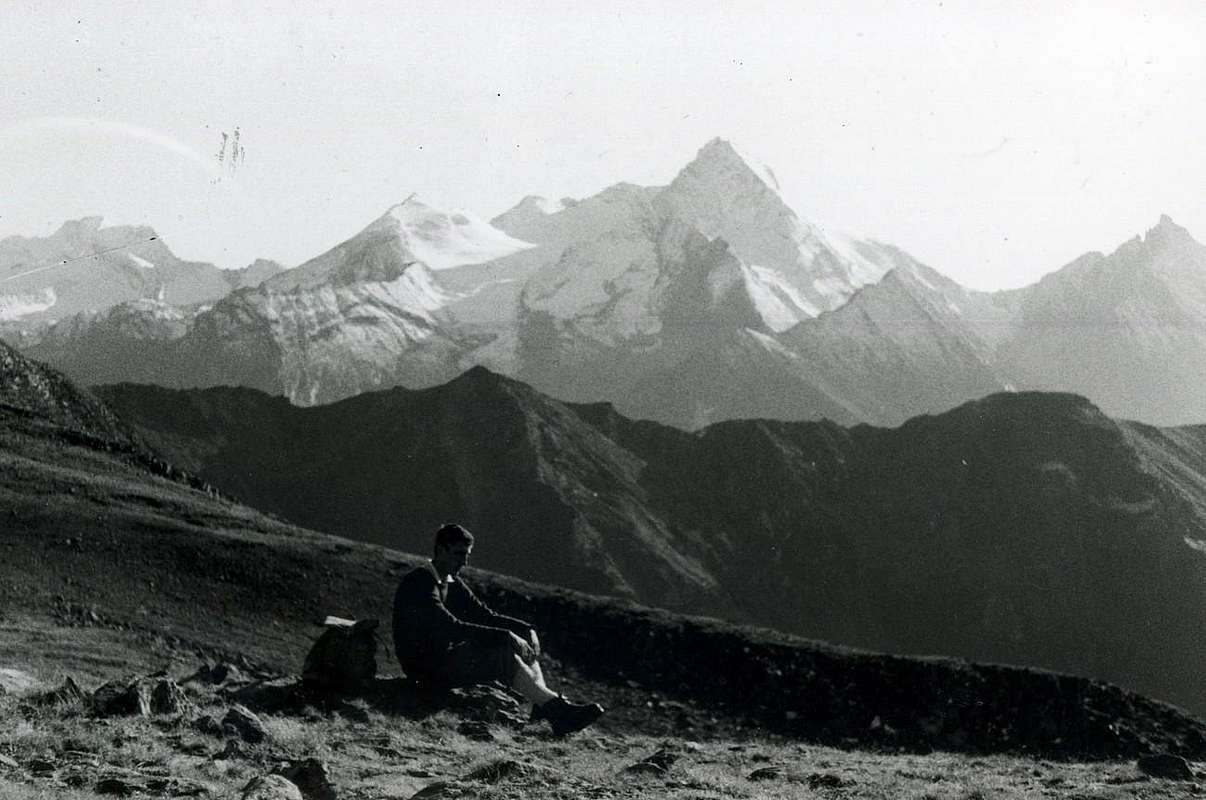
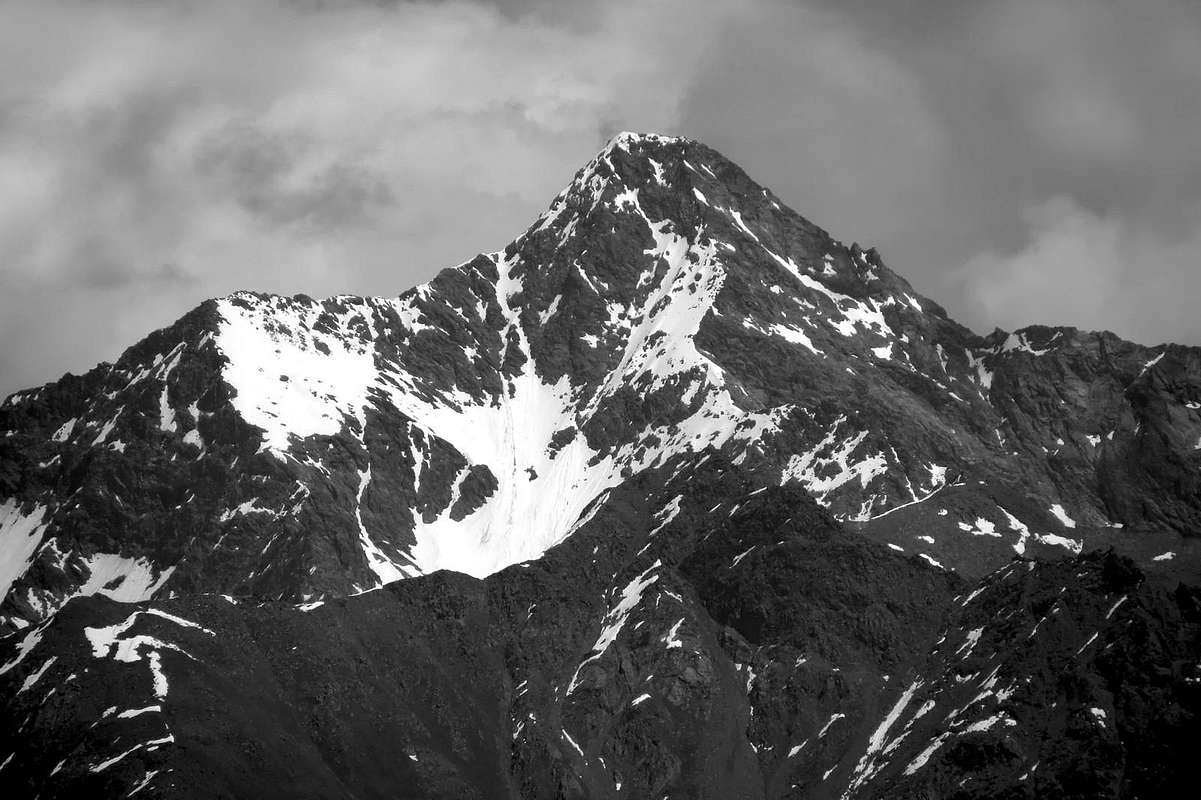
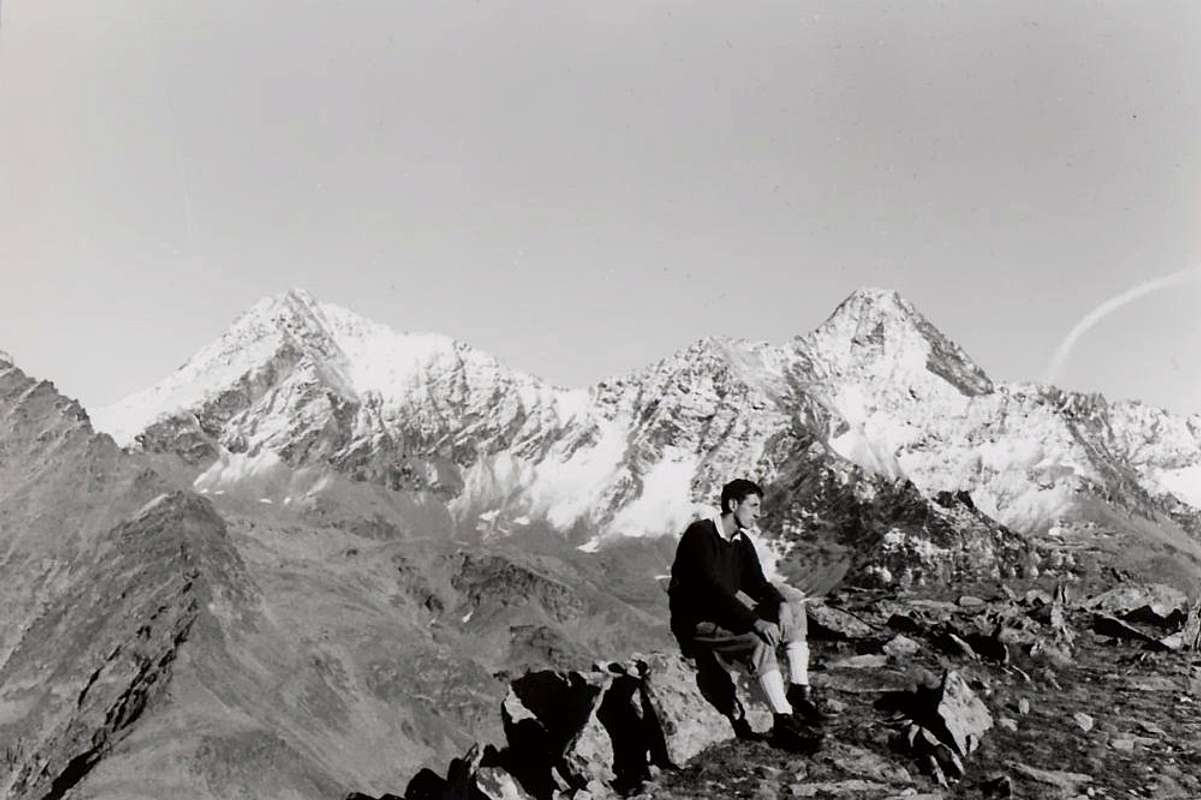


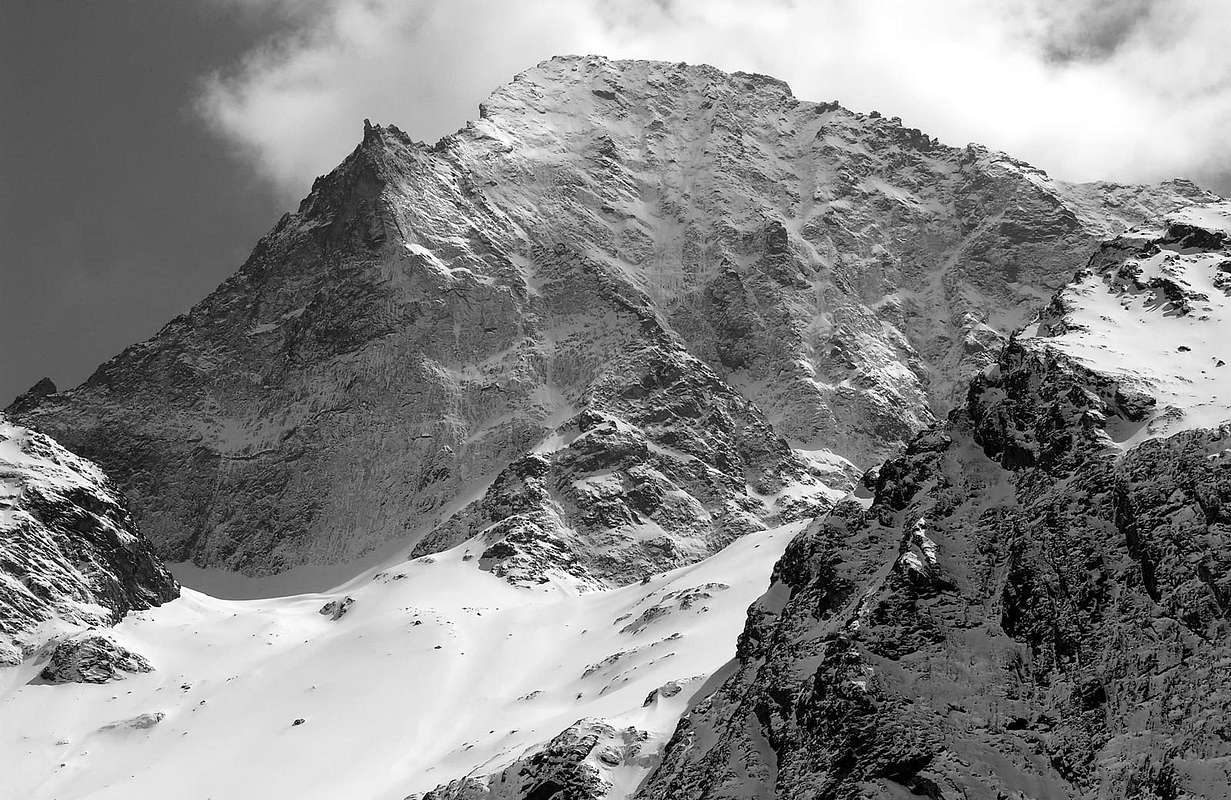
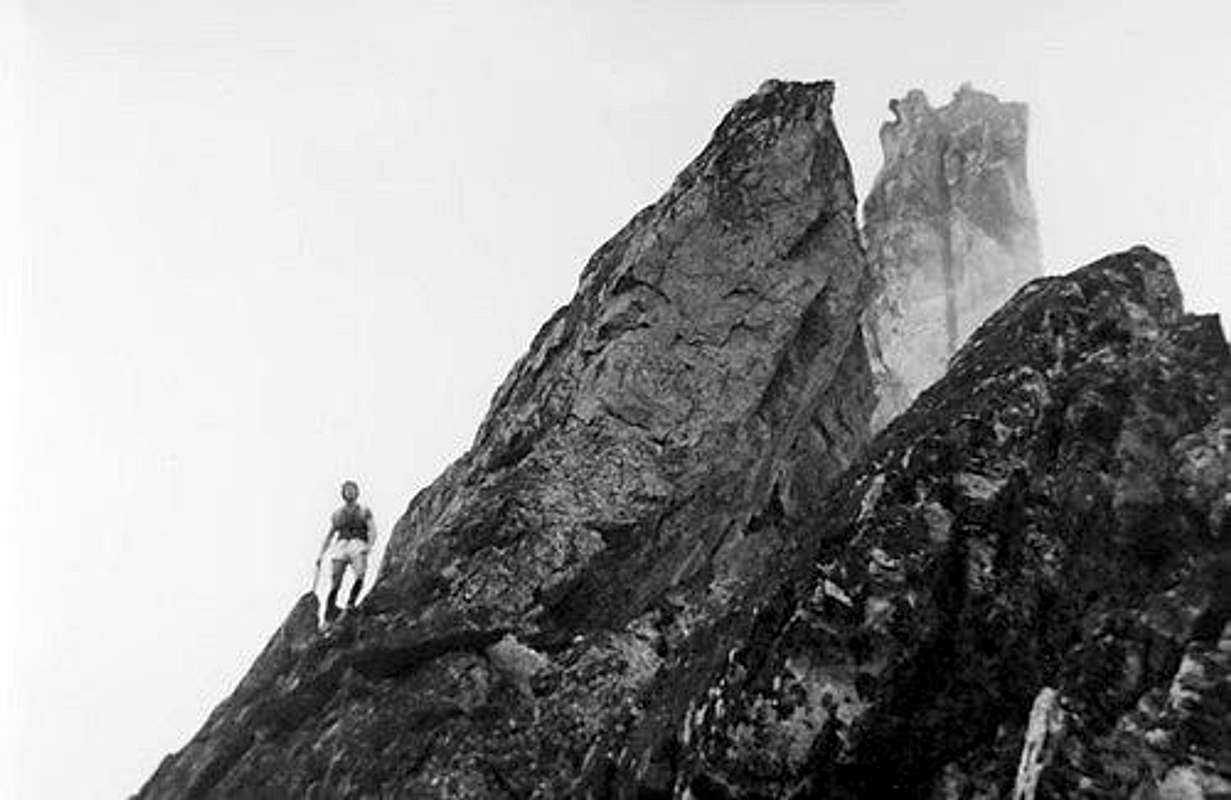
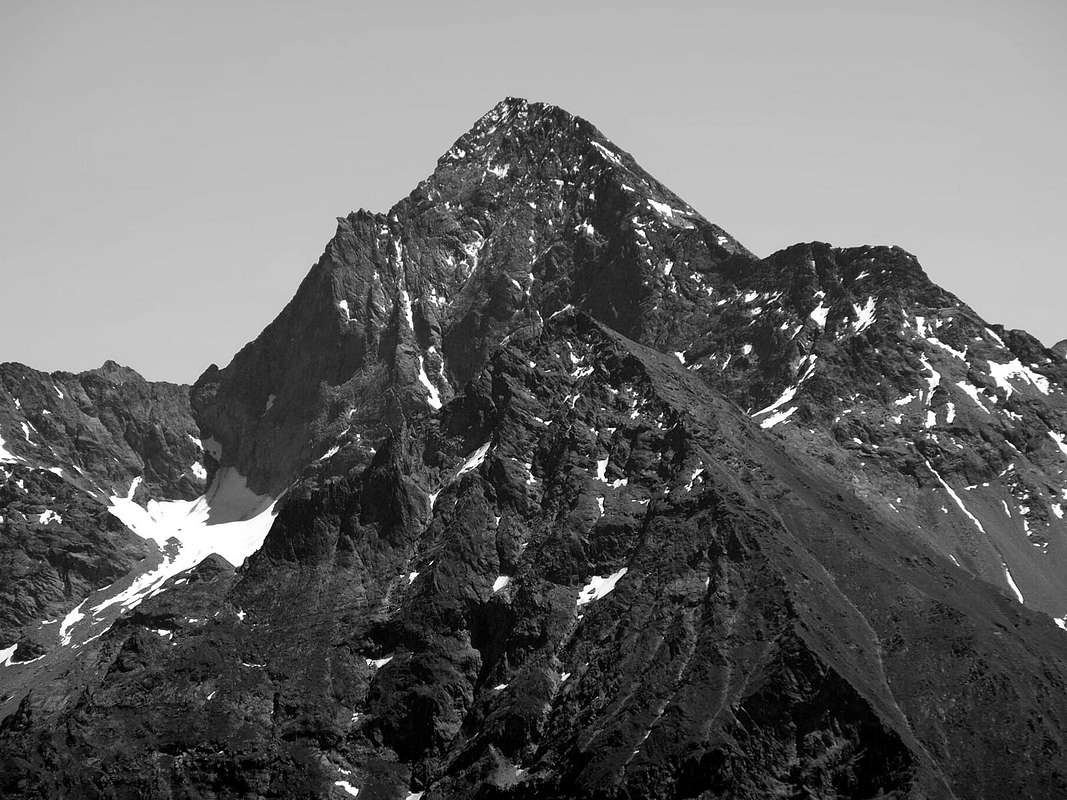

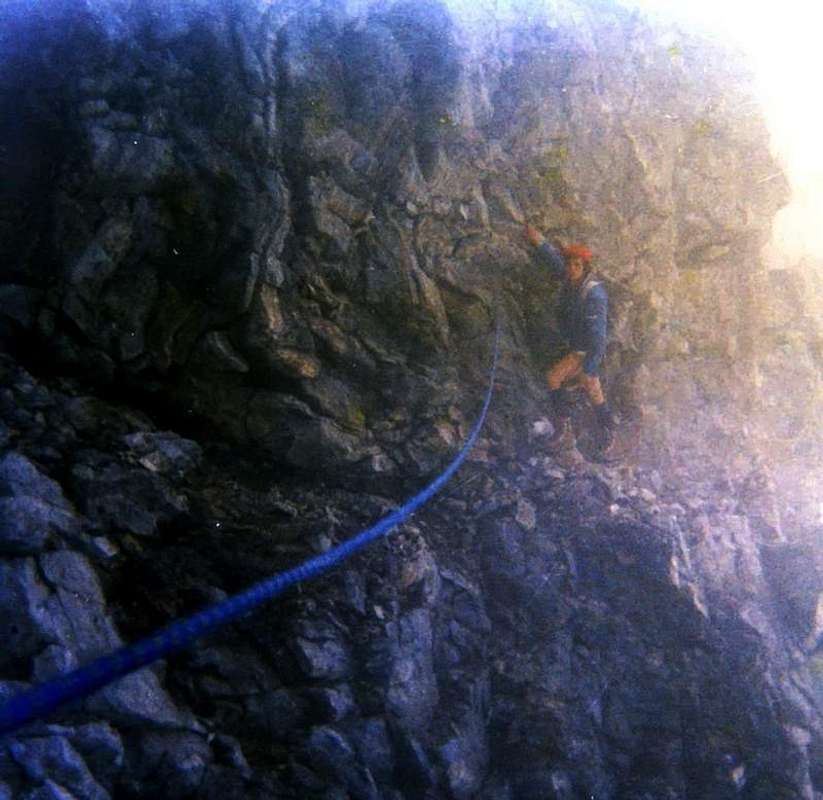
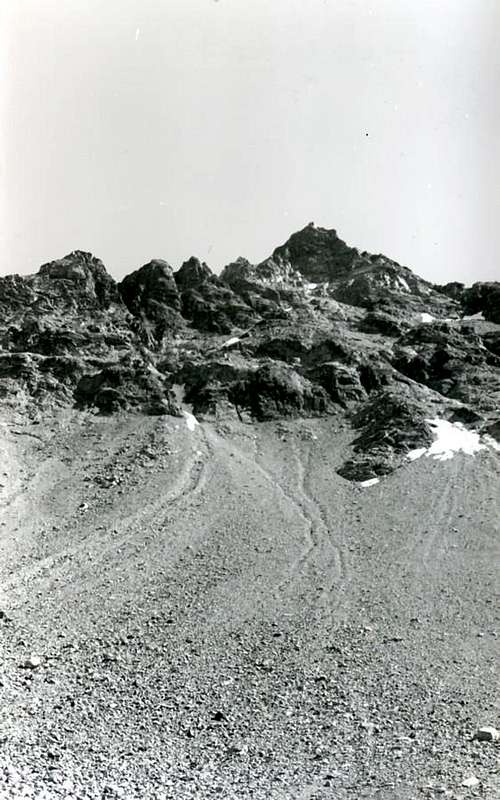

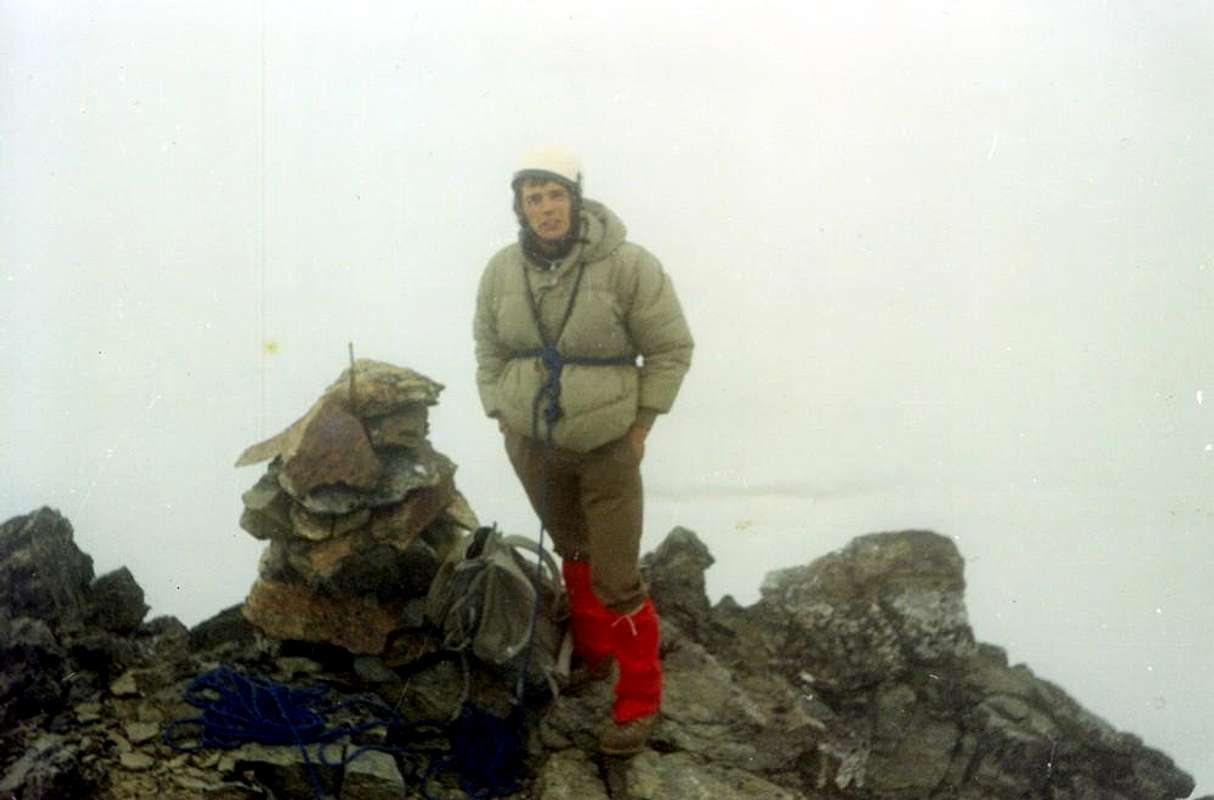

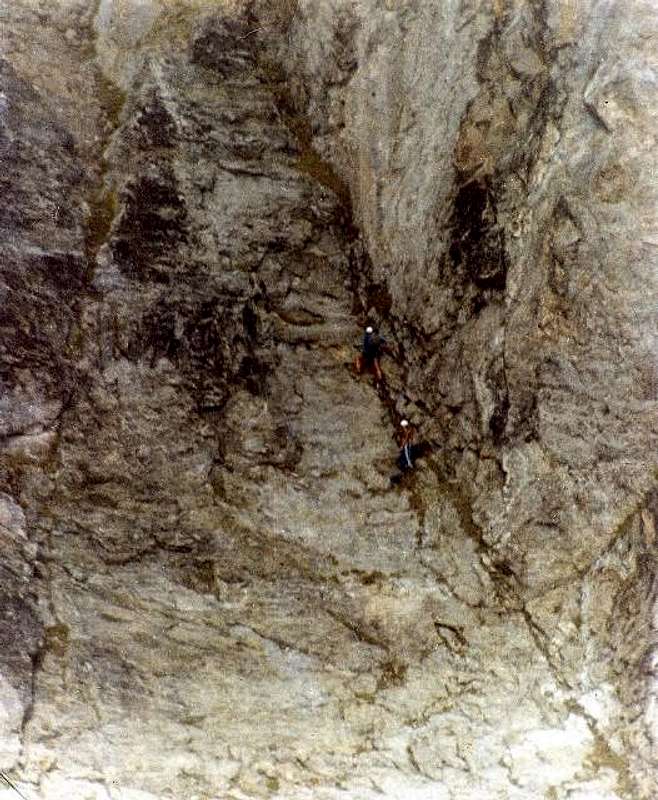

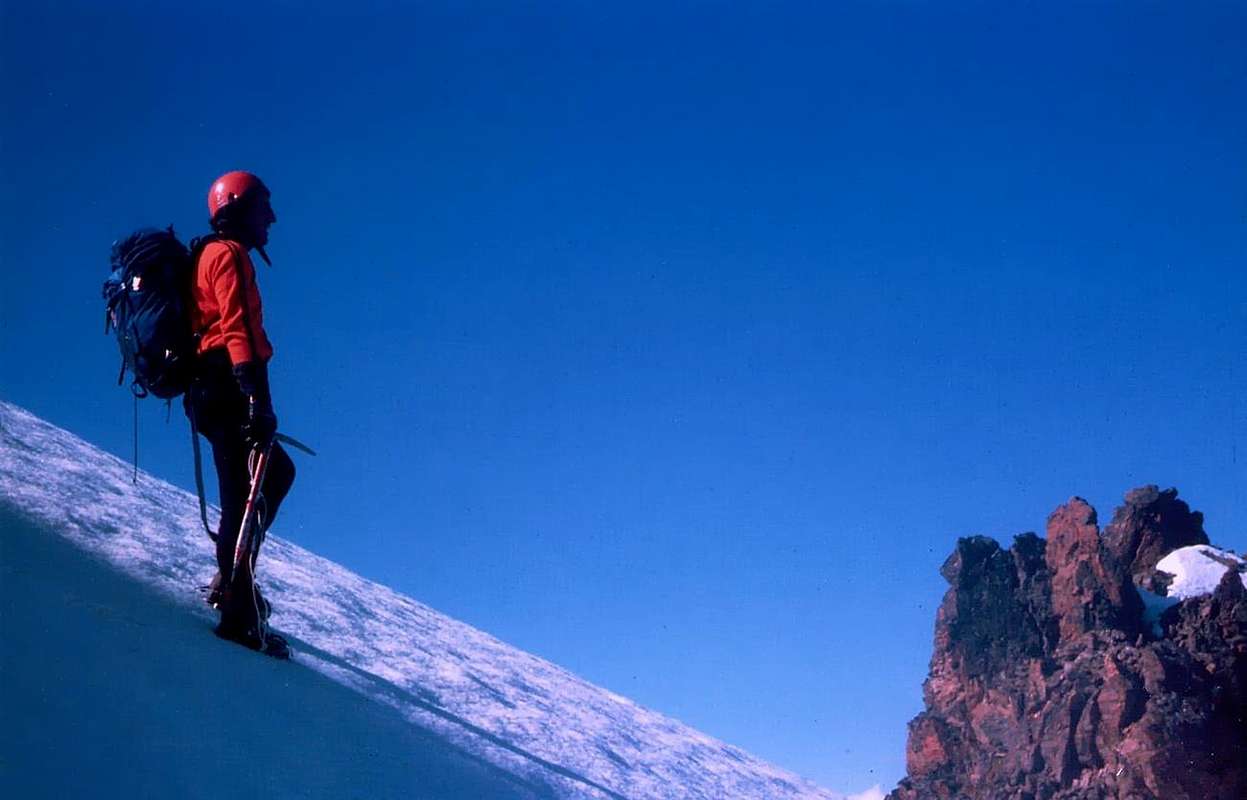

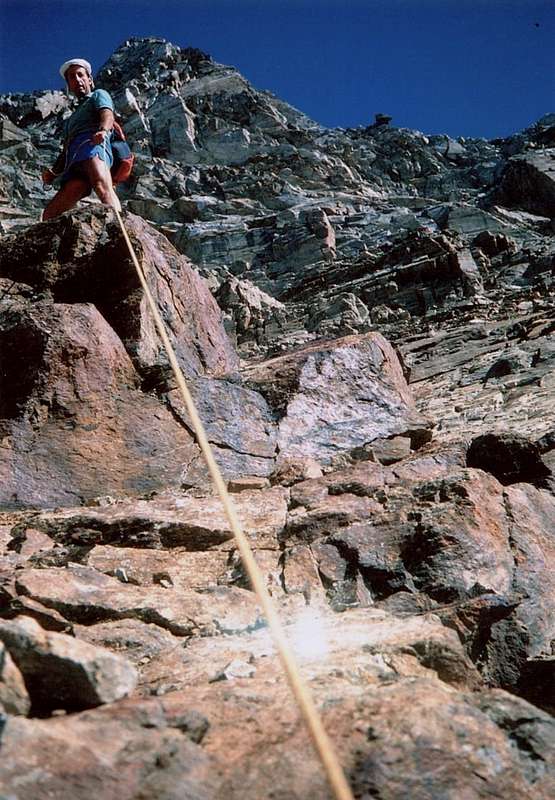

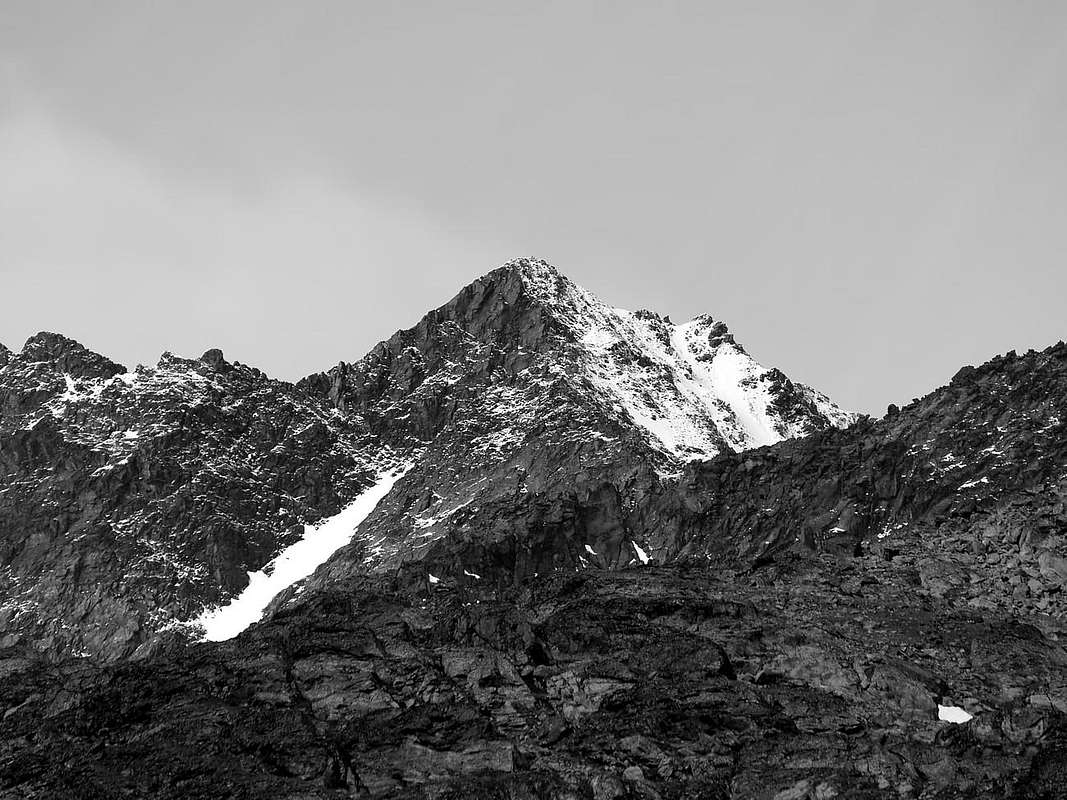
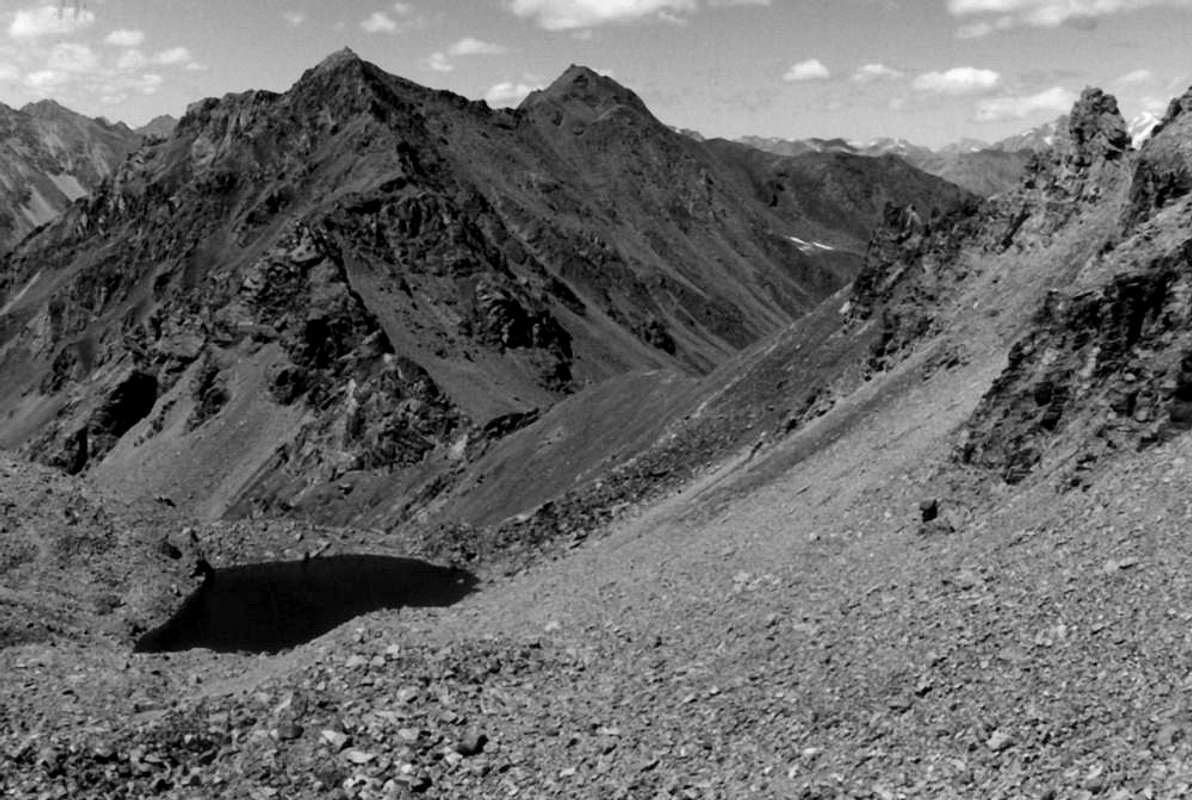
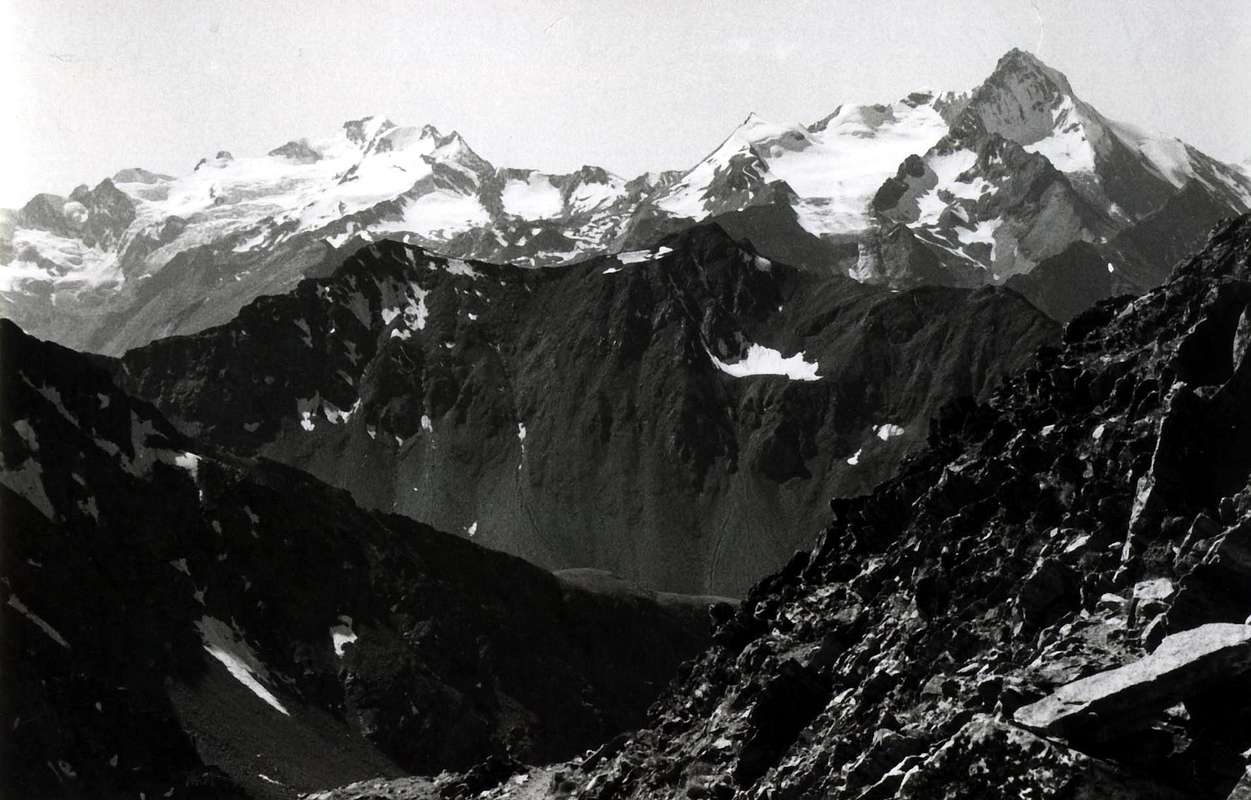




Comments
Post a Comment